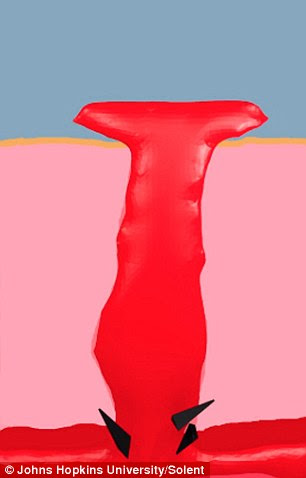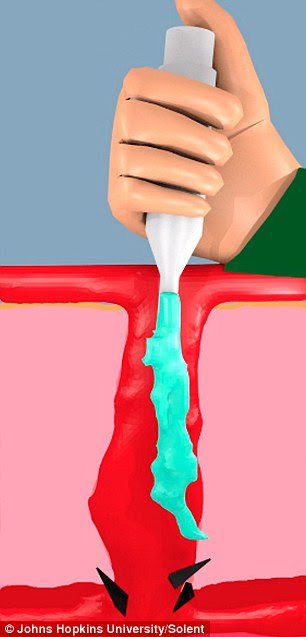The 'injectable foam' that could stop soldiers bleeding to death on the battlefield
- Researchers in Maryland unveil device to help soldiers survive injuries
- Their 'injectable foam' can be applied to deep wounds to stem bleeding
- The device is much more effective than traditional gauze or tourniquets
- When applied foam fills the wound and stops blood escaping
- Foam is stored in a canister and has a shelf life of at least a year
Scientists have invented a pioneering 'injectable foam' device to save wounded soldiers from bleeding to death.
The groundbreaking treatment is designed to stem blood loss while casualties are rushed from the battlefield to a hospital or medical station.
Biomedical engineers developed the technology after finding traditional methods often can't be used on deep neck, shoulder or groin wounds.

Scientists have invented a pioneering 'injectable foam' (prototype device pictured) to save wounded soldiers from bleeding to death. The groundbreaking treatment is designed to stem blood loss while casualties are rushed from the battlefield to a hospital or medical station
HOW DOES THE FOAM WORK?
Two liquid chemicals which rapidly form a foam when mixed are stored separately in canisters in an injector device the size of a marker pen.
In action, a soldier would mix the two chemicals inside the injector and push down on a plunger to insert the expanding foam into a colleague's wound.
By filling the wound area, it blocks blood loss during the critical first hour until patients can receive urgent medical treatment.
The canisters can keep the chemicals - a polyol and a diisocyanate - stable in military conditions at up to 38°C (100°F) for at least a year.
Student Sydney Rooney, from John Hopkins University, in Baltimore, Maryland, led the team as part of a course project.
They came up with the injectable foam system aimed to stop profuse bleeding from a wound near a limb or the head.
Such wounds can typically be difficult to stem, as finding the exact source of blood loss is tricky.
Eight undergraduates at the American university came up with the idea to beat the weaknesses of using a traditional tourniquet or a gauze pad with a clotting agent.
They can be difficult to apply effectively to deep wounds on neck, shoulder and groin injuries.
Ms Rooney said the group wanted to stop soldiers losing more than half their blood before getting to a medical station.
'The problem is that damage from bullets and bone fragments deep inside a wound is not always visible from outside the body,' she said.
'A regular clotting agent may not be able to reach the origin of the bleeding.
'We came up with a foam injection system that fills the wound area and blocks the blood loss.
'Our project has been dealing literally with a life-and-death matter and at the end of the day, that provided some extra motivation for our team.'


The foam is designed to help stem bleeding when a wound opens up (left). If left untamed the large loss of blood can threaten the survival of a soldier (right). The researchers came up with the injectable foam system aimed to stop profuse bleeding from a wound near a limb or the head


Two liquid chemicals which rapidly form a foam (left) when mixed are stored separately in canisters in an injector device the size of a marker pen. In action, a soldier would mix the two chemicals inside the injector and push down on a plunger to insert the expanding foam into a colleague's wound (right)

By filling the wound area, it blocks blood loss (shown) during the critical first hour until patients can receive urgent medical treatment. The groundbreaking treatment is designed to stem blood loss while casualties are rushed from the battlefield to a hospital or medical station
The students carried out experiments with a gel that mimics the consistency of human tissue.
They then used a rod to create 'blood vessels' filled with water within the gel and carved 'wounds' into the gel to simulate the bleeding process.
Team member Allie Sanzi said: 'The foam fills up the wound opening, hardens, and applies pressure to the walls of the cavity.
'This should lead to more-effective targeting and treatment at the source of the bleeding.'
Two surgeons proposed and supervised the project at All Children's Hospital, a Johns Hopkins Medicine facility in Saint Petersburg, Florida.
This is a clinical training site for medics in the Green Berets, Navy Seals and Army Rangers.
One of the surgeons, Dr Paul Danielson, a military veteran, said the prototype was very promising.
'I don't think it's pie in the sky at all,' he said.
'I think it's a very viable solution to a problem that's been plaguing us on the battlefield.'
All Children's pediatric surgeon Nicole Chandler raised the group's 'simple, intuitive' design and said it had the 'potential to save many lives'.
While no human testing has yet taken place, the students have received university approval to begin animal testing of the prototype system.




No comments:
Post a Comment